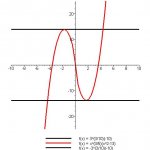red and white kop!
Junior Member
- Joined
- Jun 15, 2009
- Messages
- 231
ok so for the function f(x) = (x^(3/5))(x^(2)-13) (the many parentheses are to make it clear) i am supposed to find f'(x) and the intervals in which f(x) is decreasing and increasing
i found f'(x) = (13/5)(x^(-2/5))(x^(2)-3)
i think this is correct
but then to find the increasing and decreasing intervals i got it wrong
i started with the increasing interval and got x>sqrt3 and -sqrt3>x>0, i keep doing it over and over but i dont understand where its wrong
i found f'(x) = (13/5)(x^(-2/5))(x^(2)-3)
i think this is correct
but then to find the increasing and decreasing intervals i got it wrong
i started with the increasing interval and got x>sqrt3 and -sqrt3>x>0, i keep doing it over and over but i dont understand where its wrong

